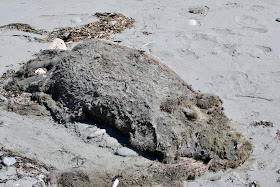Saturday 9/1/2012
 |
| Still in Forks, WA, we took our next day drive south on Hwy. 101 to Ruby Beach. |
 |
| On our drive to Forks in the Nest, we had to by pass this area, so we wanted to go back and visit it. |
 |
| Views of Olympic National Park Ruby Beach from half way down on the trail. |
 |
| Ruby Beach is covered in rocks, tree trunks, |
 |
| and sea stacks. |
 |
| Joe peaking through the sea stack hole. |
 |
| We walked as far as we can go. |
 |
| The beach further north was getting swallowed up by the sea. |
 |
| On the way back, Joe spots this object on the beach. It was covered in flies and maggots. It looked like a pig, wild or domestic. Where did he/she come from? Did it get caught in high tide? |
 |
| More of the perfectly smooth and round Pacific coast rocks. |
 |
| Some of the tree trunks on the beach are huge. |
 |
| Mallery and I climb and conquered the trunk. |
 |
| Out at sea we saw a lighthouse on an island. |
 |
| Destruction Lighthouse out about a mile off shore. |
 |
| After enjoying our lunch we started to drive back north on Hwy. 101. |
 |
| About 12 miles south of Forks, WA, we turned east on Hoh Rain Forest Road. |
 |
| After a few miles we came to the Olympic National Park entrance gate. If you don't have a annual pass you will pay $15 to get in. |
 |
| As we drove further into the park, we saw a sign just next to the road for another giant tree. This Sitka spruce is 270 feet tall, and is 500 to 550 years old. |
 |
| Moss laded trees everywhere. |
 |
| Hoh Visitor Center is 18 miles east from Hwy. 101 |
 |
| There are 3 short trails that you can take once at the Visitor Center. For the professional hikers, there is a 17.3 mile hike. |
 |
| We chose the Hall of Mosses Trail. |
 |
| While on our hike, I learn that the pregnant trees that I have seen, are tumors caused by early insect damage or virus. |
 |
| I let Joe brave the trail first to make sure it was safe. |
 |
| Santa Claus mushroom on a moss covered evergreen tree. |
 |
| This rain forest receives over 200 inches of rain per year. |
 |
| This arched bough is covered with lush beards of clubmoss that is feed by the light and air. |
 |
| The environment supplies enough moisture and air born nutrients to keep the moss alive on the bough. |
 |
| This forest is one of the only coniferous rain forest in the world. |
 |
| When trees do fall and die, they become nurse trees and support moss, lichen and other trees on it. |
 |
| These two trees once lived on a down nurse truck before it deteriorated away. |
 |
| Nurse truck completely gone, but still evident that it use to be there. |
 |
| This giant tree was 190 feet tall. |
 |
| It took two pictures to show the size of the tree, and another portion of the tree is further in the forest. |
 |
| As we get to the end of the trail, I took this picture of a moss covered trunk leaning over a stream. The floor of the stream is also covered in bright green moss. |
 |
| As we walk toward the car, we saw this old pay phone covered in moss. |

No comments:
Post a Comment